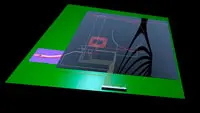Electronics News
Archive : 3 July 2017 год
 Working in collaboration with Lionix, researchers from the University of Twente have developed a diode laser on a chip with a bandwidth of 290Hz. According to the team, this is the most accurate such device yet created.
Working in collaboration with Lionix, researchers from the University of Twente have developed a diode laser on a chip with a bandwidth of 290Hz. According to the team, this is the most accurate such device yet created.
Professor Klaus Boller noted: “Our signal is more than ten times more coherent – or clean – than any other laser on a chip.”
The newly-developed laser – a hybrid device wth two photonic chips connected optically – is also tunable, which means that users can select the particular wavelength, within a broad range.
The reseachers believe their development will bring ‘countless applications’ within reach, including the control of movable antennae on phone masts for 5G mobile internet, faster data flows through fibre networks, more accurate GPS systems and better sensors for monitoring structural integrity.
Author
Graham Pitcher
Source: www.newelectronics.co.uk
 Researchers at Linkoping University say they have discovered how to control and transfer spinning electrons and believe this could pave the way for novel hybrid devices that could outperform existing electronics components.
Researchers at Linkoping University say they have discovered how to control and transfer spinning electrons and believe this could pave the way for novel hybrid devices that could outperform existing electronics components.
The work is based on topological insulators, which are insulators on the inside, but conduct on their surface. One property of topological insulators is that an electron must travel in a specific direction along their surface, determined by its spin direction – or ‘spin-momentum locking’.
“The surface of a topological insulator is like a well-organised divided highway for electrons, where electrons having one spin direction travel in one direction, while electrons with the opposite spin direction travel in the opposite direction. They can travel fast in their designated directions without colliding and without losing energy,” said researcher Yuqing Huang. However, one issue is how to generate and manipulate the surface spin current.
The research team says it has taken the first step towards transferring spin-oriented electrons between a topological insulator and a conventional semiconductor by generating electrons with the same spin in gallium arsenide. To achieve this, they used circularly polarised light, in which the electric field rotates either clockwise or anticlockwise when seen in the direction of travel of the light. Spin-polarised electrons could then be transferred from GaAs to a topological insulator, to generate a directional electric current on the surface.
According to the team, it could control the orientation of spin of the electrons and the direction and the strength of the electric current in the topological insulator bismuth telluride without applying an external electric voltage. This is said to be significant for the design of opto-spintronic devices that exploit the interaction of matter with light.
"We have combined the superior optical properties of GaAs with the electrical properties of a topological insulator,” said Professor Wemin Chen. “This has given us new ideas for designing opto-spintronic devices that can be used for efficient and robust information storage, exchange, processing and read-out in future information technology.”
Author
Graham Pitcher
Source: www.newelectronics.co.uk

